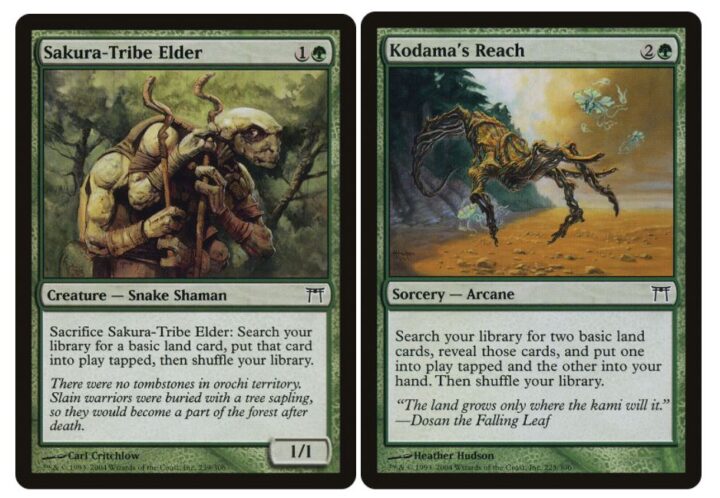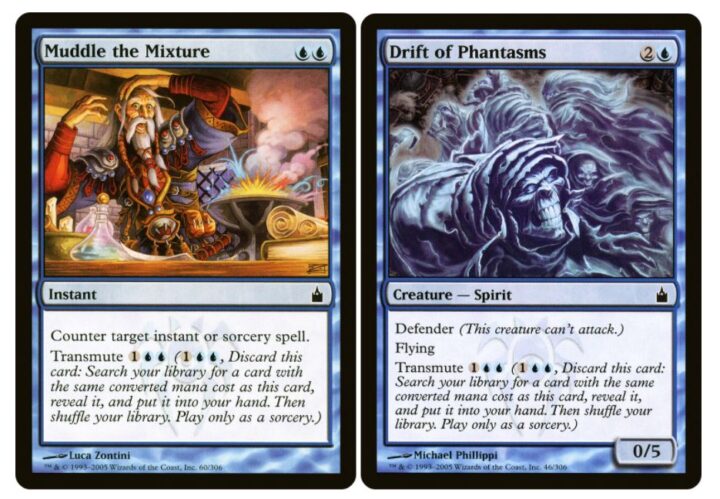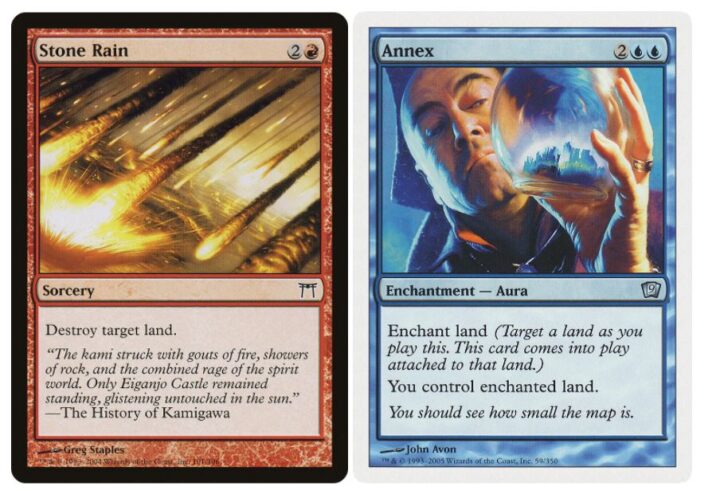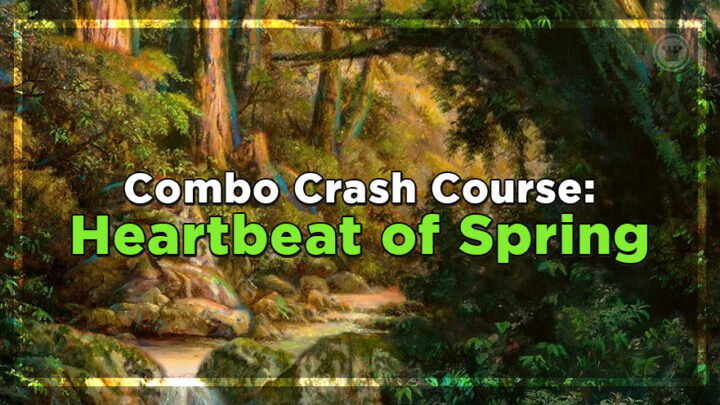Welcome back to Combo Crash Course, our semi-regular exploration of Magic’s greatest combo decks. In the first few installments of this series, we’ve shown off a variety of different approaches to combo, and today we’re adding another one: what I call a “non-deterministic” combo game plan.
We say a player has “a deterministic kill” when their deck has passed the point where bad luck or interaction can interfere, even if the actual victory could take quite a few steps to achieve. A classic A + B combo like Splinter Twin will usually kill the opponent regardless of life total or board state. Angel’s Grace + Ad Nauseam is also a deterministic kill in most contexts, even if you have to draw through an unpredictable sequence of cards to get there. The important thing is that the victorious outcome is known at the outset of the combo, with the key spells remaining consistent from game to game. The skill-testing gameplay in such decks therefore revolves how one assembles those key spells – what comes after is at best a memory exercise.
But occasionally, we see combo decks that involve a more free-wheeling, improvised accumulation of resources, rather than assembling a set of cards and going infinite. Prominent examples of this include all variants of Storm, as well as Eggs, KCI, Cheerios, NeoBrand, and most Turns decks. Due to these variable combo routes, players must evaluate their odds of comboing on a turn-by-turn basis, depending on the resources they have.
This constant puzzle-solving and improvisation encourages players to seek ever-deeper mastery of the deck, which is how archetypes like Storm build up such strong shared identity among longtime players. We’re not going to break down Storm today, but rather one of its distant cousins: a deck that transmuted some unusual set keywords, overlooked rares, and an all-basic mana base into a memorable Standard powerhouse. In anticipation of Magic’s impending return to Kamigawa, let’s look at the most Kamigawan combo of all time.
WHAT IS HEARTBEAT?
Heartbeat of Spring is an iconic and powerful Kamigawa card. But like almost all “symmetrical” effects, it’s only really good when you’re breaking that symmetry. In Standard tournaments circa 2006, the best way to do that was with Early Harvest and a ton of basic lands. This does hinder your color access a bit, but mostly just in the first two turns. After that, we can rely on some other great Kamigawa staples to both ramp and fix our mana in preparation for the combo.

Having loaded up on enough basics to start comboing, we can use Heartbeat to efficiently turn cards (i.e. copies of Early Harvest) into mana, then efficiently turn the mana into lethal damage with Maga, Traitor to Mortals or Invoke the Firemind.
Of course, that’s only half the story. What I’ve described so far is effectively a four- or five-card combo; history tells us that you won’t be able to draw into the pieces before you’re gobbled up by the various creature threats of the format (in this case, Watchwolf and Magnivore). But Heartbeat has the near-unprecedented ability to exchange the cards it draws for the cards it wants to draw – and without having to waste any more slots on uninteractive tutor spells.

A big part of that capacity is transmute. The OG Dimir guild ability proved very powerful in Standard, and Heartbeat was likely the best example. Three-mana tutors are strong even at sorcery speed; between these two cards, you can transmute into all but one of the remaining spells in this deck! Hard-casting them is more of a backup plan, but it’s still a plan you’re grateful to have. Muddle the Mixture wasn’t much worse than Negate in this pre-planeswalker era, and Drift of Phantasms can block for a crucial turn or two against aggro. More than Gifts Ungiven would block for, at the very least.
The second element of this card-tutoring engine is Weird Harvest. Like Heartbeat, this is an undercosted effect that has been “balanced” by having you share the benefit with your opponent – but that’s irrelevant most of the time, since you’ll aim to win the turn you cast it. If Heartbeat + Early Harvest is your plan to turn cards into mana, Weird Harvest + Drift of Phantasms gives you a way to efficiently convert that mana back into a second round of cards. The sheer number of branching options from this card alone is one of the keys to Heartbeat’s combo potential.
The most obvious use is to just grab all remaining Drifts from the deck and transmute those for extra copies of Early Harvest, Recollect and Heartbeat, plus Invoke the Firemind. But sometimes, you’re tight on mana or copies of Drift, so it’s good to directly search up creature cards where they’re useful – Maga as your kill card, Sakura Tribe-Elder to boost the mana return on your next Early Harvest, or sideboard tech like Loaming Shaman or Meloku the Clouded Mirror.
AND TO TOP IT ALL OFF…
Maybe Weird Harvest + transmute still falls a little short of your expectations for a dominant Standard engine, even in 2006. But that’s where the signature card of Kamigawa Standard makes its impact felt. Sensei’s Divining Top was the Lurrus or Yorion of its day, appearing across a swathe of archetypes and disproportionately shaping deck building habits and play patterns. But very few Standard decks maximized its potential as Heartbeat did.
Like any top deck manipulation effect, the Top draws most of its power from shuffling. Each time you’re able to shuffle with some other effect in between Top activations, you’ve practically drawn three more cards – or, at least, had the opportunity to draw them. And with all that transmuting and land-ramping and Weird-Harvesting, this deck is the absolute king of generating incidental shuffles.
So while on the surface, it seems hard to tutor into counterspell protection for your combo through the Weird Harvest chain, a Top and plentiful Heartbeat mana makes it very achievable! All you need is a Remand in your top three cards, and then you just trade in your Top with the tap ability to draw the counterspell before continuing on with your turn. In a desperate spot, you can generate even more shuffles with a spare ramp spell, incidental transmute, or even the forbidden “Weird Harvest for 0.” The Top never stops, my friends!
The card selection and information-gathering power of Top is a huge boost to both the power and the complexity of Heartbeat. There are simply too many possibilities each turn – and too many limitations, due to mana or finite copies of each card – to ever trivialize its avenues to victory. Despite maintaining its popularity throughout its Standard season, the deck never stopped evolving week to week, tournament to tournament – as did the tricks and strategies of its pilots. While Heartbeat could never scale up to non-rotating formats quite as well as Storm, there are still dedicated brewers tinkering with the card decades after the deck left Standard.
HOW TO BEAT IT?
One of the trademark strengths of non-deterministic combo decks is resiliency, particularly against countermagic or discard spells. Normally, these answers are great against combo strategies; you can just hold mana up to stop a key piece like Splinter Twin or Living End, and usually not feel much pressure from whatever else they cast.
But what do you do when every card in the deck is a roughly-equivalent combo piece? Like Enchantress and other resource-accumulating decks, your window to shut down Heartbeat with one-for-one answers is only open for two or three turns. After the first copy of its namesake enchantment hits the board, the deck can just keep casting spell after spell, overwhelming blue mages through redundancy.
Even before it reaches critical mass, Heartbeat can force counterspell decks on the defensive by ramping, then punish them for holding up mana by using transmute (which is activating an ability, not casting the spell) instead of playing into it. And lest we forget that the deck is packing some powerful blue interaction itself – four Muddle and four Remand is quite the arsenal when Heartbeat needs to defend itself on the stack, and Gigadrowse could make the point moot by tapping you out on your end step, leaving you powerless against the ensuing combo.
Discard spells were quite powerful in Standard at the time, with Persecute, Hypnotic Specter, Dimir Cutpurse, Okiba-Gang Shinobi and Castigate all seeing play. But the sheer redundancy and card selection made it hard to keep Heartbeat from assembling its pieces for long. Skilled Heartbeat pilots could even “hide” important cards on top of their libraries using Divining Top, to avoid drawing them before the combo was ready.

As a result, many opponents settled on attacking what few permanents Heartbeat offered as targets – Heartbeat of Spring itself, and those signature basic lands. Even then, the superior resource generation and redundancy of Heartbeat meant that such disruption either had to come alongside a fast clock, or it had to specifically target the few irreplaceable parts in the plan. For instance, the main reason for playing both Maga and Invoke the Firemind was to avoid losing to a single resolved Cranial Extraction!
Even then, canny opponents could hold onto a Ghost Quarter until the Heartbeat player put their Swamp or Mountain into play. Since the deck only had room for one of each basic, successfully destroying it would at best force them to scramble for a Recollect before they could threaten a kill.

Like most successful combo strategies, Heartbeat could adopt different lines in order to avoid such blowouts if it sensed the danger. But this at least slowed the combo kill down by a turn or more, adding yet another layer of risk assessment to the ever-present “go for it?” calculations. Is it worth committing your single Mountain to the board in order to cast Kodama’s Reach on curve, or should you just wait and hope to draw a less important land next turn? Should you play Heartbeat a turn early to guarantee you have enough mana to kill, or will they trump you with Angel of Despair or Yosei, the Morning Star before you untap? In some cases, the best way to disrupt Heartbeat was to successfully bluff and confuse them into playing scared, giving your own plan room to flourish.
THE DECK THAT STOLE MY HEART
I admit that talking about Heartbeat combo in 2022 is a purely academic exercise. This combo shell never made the jump across to Modern or Legacy, where faster kills make its arcane tutoring chains obsolete, and better interaction can overcome its advantage in efficiency and redundancy. For better or worse, such a gloriously messy and unlikely pile of spells could only really be justified in a smaller card pool, and so Heartbeat has been relegated to a footnote in Magic’s long history.
But the wonder of its brief existence was enough to excite my own interest in Constructed as a new Magic player, and challenge my early perceptions of how deep a deck’s strategy might run. The lessons Heartbeat taught us carry through to more recent resource-accumulation shells like Wilderness Reclamation, Lotus Field combo and Enchantress, and even other formats like cEDH where complicated tutor-chains are the norm.
I never got to play Heartbeat combo while it was legal in Standard. But nothing has stopped me from rebuilding it now and again in the years since, just to goldfish a few hands, or play it casually against friends. WotC have themselves made a historically-accurate Heartbeat deck available to play in “retro Standard” events on Magic Online, cementing its status as one of the more memorable combos of rotations past.
In general, I am a huge supporter of just going back and playing games with older decks for fun! Even if you can’t reconstruct the exact context and metagame they hail from – and even if the match-ups aren’t precisely balanced – there’s a different sense of satisfaction on offer, like joy-riding in a historic sports car. Allowing yourself to get excited over Drift of Phantasms is an experience every Magic player should enjoy – even if they’re about 15 years late to the party.

Tom’s fate was sealed in 7th grade when his friend lent him a pile of commons to play Magic. He quickly picked up Boros and Orzhov decks in Ravnica block and has remained a staunch white magician ever since. A fan of all Constructed formats, he enjoys studying the history of the tournament meta. He specializes in midrange decks, especially Death & Taxes and Martyr Proc. One day, he swears he will win an MCQ with Evershrike. Ask him how at @AWanderingBard, or watch him stream Magic at twitch.tv/TheWanderingBard.

